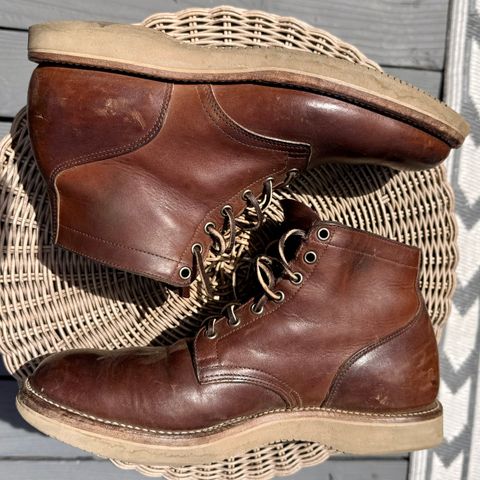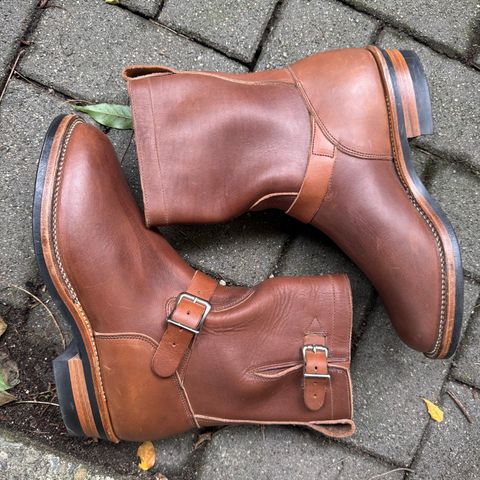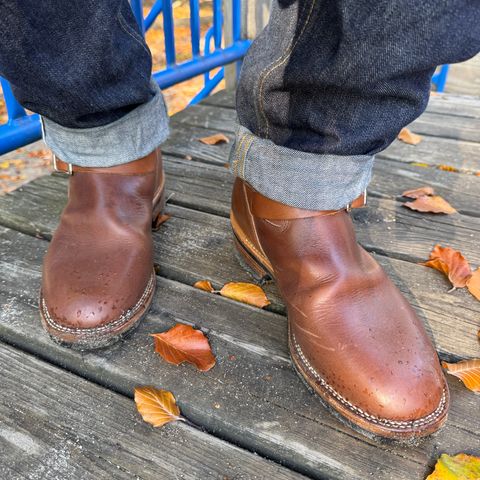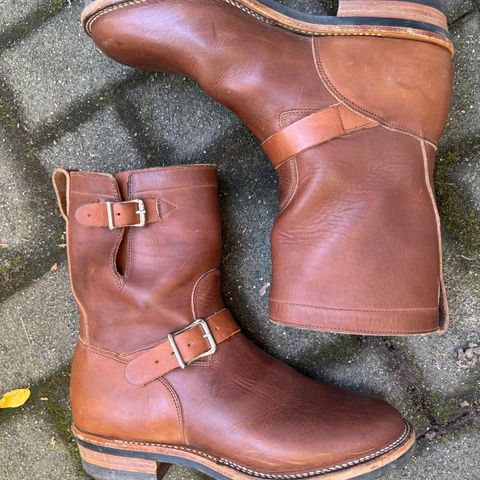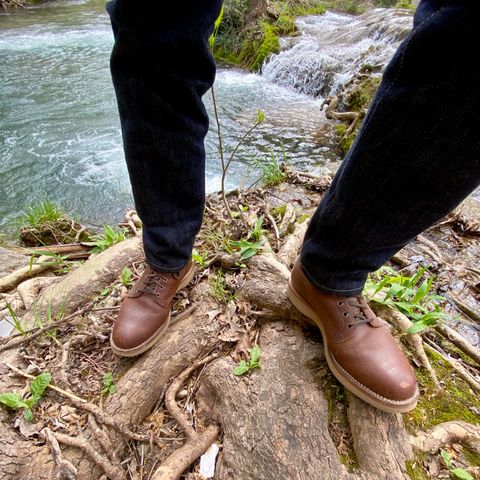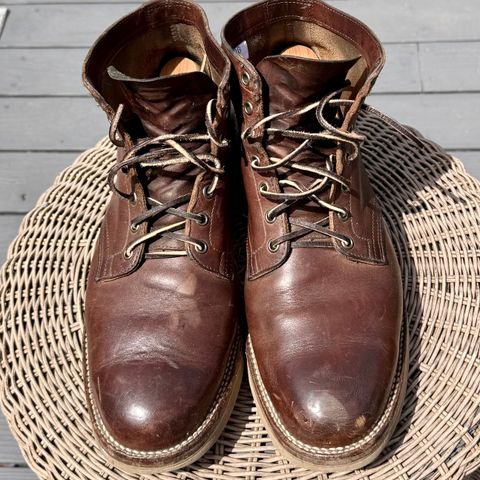About
Crust Chromexcel is a semi-finished leather variant produced by Horween Leather Company that represents the intermediate stage of Chromexcel production before final dyeing and finishing. Crust leather has been tanned and dried but remains undyed, providing a natural foundation for custom coloration and finishing applications. This state makes it particularly valuable for craftspeople and manufacturers seeking maximum customization potential in their leather goods.
About
Crust Chromexcel is a semi-finished leather variant produced by Horween Leather Company that represents the intermediate stage of Chromexcel production before final dyeing and finishing. Crust leather has been tanned and dried but remains undyed, providing a natural foundation for custom coloration and finishing applications. This state makes it particularly valuable for craftspeople and manufacturers seeking maximum customization potential in their leather goods.
The term "crust" derives from the natural outer coating characteristics of the leather surface at this stage of production, representing the hard outer shell appearance that develops after tanning but before final processing. Crust Chromexcel maintains all the fundamental characteristics of the full manufacturing process while offering the flexibility of custom finishing, making it highly sought after for specialized applications in heritage footwear and custom leather goods.
As part of Horween's Chromexcel line, crust maintains the signature combination tanning process and hot stuffing procedures that create the distinctive pull-up effects associated with the leather type, while providing craftspeople with the ability to achieve any color or finish desired on the foundation of premium American leather craftsmanship.
Manufacturing Process
Crust Chromexcel undergoes the complete Chromexcel manufacturing process up to the final dyeing and finishing stages. The production begins with the standard 89-step process that takes 28 working days, utilizing all five floors of Horween's Chicago facility. The combination tanning process starts with chrome tanning using chrome salts, creating the characteristic "wet blue" hides that form the durable foundation of the leather.
The vegetable retanning process follows using Horween Leather Company's proprietary bark extract recipe, adding the roundness and fullness characteristics that enhance aging potential. This retanning stage distinguishes combination-tanned leather from purely chrome-tanned materials, providing the structural benefits that make Chromexcel suitable for demanding applications.
Hot stuffing represents the critical process that imparts Crust Chromexcel's signature characteristics. The hides receive impregnation with Horween's secret blend of natural oils and greases, including food-grade beef tallow and cosmetic-grade beeswax. This hot stuffing process, achieved through steamed mills, creates the oils and wax content responsible for the pull-up effect that lightens the leather temporarily when stretched or flexed.
At the crust stage, the leather has achieved all physical properties including final size, thickness, fullness, looseness of grain, and any grain characteristics present in the hide. The tanned and dried leather maintains a matte finish due to the absence of final dyeing and surface treatments, providing the neutral foundation that allows for unlimited finishing possibilities.
Color and Appearance Characteristics
Crust Chromexcel displays the natural beige-tan coloration that results from the combination tanning process without applied dyes. The tone and intensity can vary from hide to hide based on the original characteristics of the raw material and the specific processing conditions, creating subtle variations that contribute to the uniqueness of each piece.
The natural canvas appearance provides an excellent starting point for patina development, as the undyed leather readily accepts oils, waxes, and environmental influences that contribute to aging characteristics. This natural foundation allows the leather to develop rich patina more readily than dyed variants, making it particularly attractive to enthusiasts who value the aging process.
The matte finish characteristic of crust leather results from the absence of final aniline dyeing and surface treatments typically applied to finished Chromexcel. This creates a more subdued appearance that emphasizes the natural grain patterns and texture inherent in the hide, providing visual interest without the glossy surface associated with finished leather.
Pull-up effects remain fully present in crust leather, with the hot-stuffed oils and waxes creating the temporary color displacement when the material is flexed or stretched. The undyed surface makes these pull-up effects more subtle than in dyed variants, appearing as variations in the natural tone rather than dramatic color shifts.
Applications and Customization
Heritage footwear manufacturers particularly value Crust Chromexcel for its customization potential, allowing them to achieve specific color and finishing requirements that match their design specifications. The semi-finished state enables precise control over final appearance while maintaining the performance characteristics that make Chromexcel suitable for demanding boot and shoe applications.
Custom finishing options for crust leather include aniline dyeing for natural color penetration, hand-buffering for textured surface effects, and specialized oil applications for enhanced softness and water resistance. These finishing techniques allow craftspeople to create unique appearances while preserving the fundamental characteristics that make Chromexcel distinctive.
Small leather goods applications benefit from the customization potential of crust leather, particularly for wallet, belt, and accessory production where specific color matching or unique finishing effects are desired. The ability to apply custom dyes and treatments makes it valuable for limited edition products and bespoke manufacturing.
The footwear industry utilizes crust leather when creating exclusive colorways or special editions that require colors not available in Horween's standard Chromexcel range. This application allows manufacturers to maintain the performance and aging characteristics of Chromexcel while achieving unique visual presentations for their products.
Aging and Patina Development
Natural aging characteristics represent one of the most compelling aspects of Crust Chromexcel, as the undyed surface readily develops patina through use and environmental exposure. The absence of surface dyes allows the natural aging process to proceed more rapidly than with finished leather, creating distinctive wear patterns and color development.
The high oil and wax content from the hot stuffing process contributes to patina development by providing the substrate for chemical changes that occur through oxidation and handling. These oils gradually migrate to the surface and interact with environmental factors, creating the deepening colors and increased richness associated with well-aged leather.
Creasing patterns develop pronounced characteristics as the leather breaks in and molds to its application, with the natural color variations becoming more distinct over time. The undyed surface shows these developments more clearly than dyed leather, making the aging process more visually apparent and appealing to users who value patina development.
Long-term aging can transform Crust Chromexcel from its initial beige-tan coloration to rich brown tones described by users as achieving "burnt sugar" appearances. This transformation occurs gradually and predictably, making it suitable for applications where long-term visual development is desired as part of the product's appeal.
Quality and Performance
Crust Chromexcel maintains all the performance characteristics that make the Chromexcel line suitable for demanding applications. The combination tanning provides both the softness and suppleness of chrome-tanned leather and the structural integrity and aging characteristics of vegetable-tanned materials.
Durability remains consistent with finished Chromexcel variants, as the fundamental tanning and hot stuffing processes that create the leather's strength and flexibility are complete at the crust stage. The absence of surface dyeing does not compromise the structural properties that make Chromexcel suitable for footwear and leather goods applications.
Water resistance characteristics result from the hot stuffing process rather than surface treatments, ensuring that crust leather maintains protective qualities against moisture penetration. The oil and wax content continues to provide protection even in the undyed state, making it suitable for applications where exposure to environmental conditions is expected.
The leather's ability to conform to applications while maintaining structural integrity makes it valuable for custom-fitted products where precise shaping is required. The combination of flexibility and strength allows craftspeople to achieve complex forming requirements while ensuring long-term performance in demanding applications.
References
"Chromexcel®". Horween Leather Company. Retrieved September 15, 2025.
"Chromexcel Leather". Oak Street Bootmakers. Retrieved September 15, 2025.
"What Does It Mean Bovine Crust Leather". BuyLeatherOnline. Retrieved September 15, 2025.
"The Attraction to Horween Chromexcel". Grantstone Shoes. Retrieved September 15, 2025.
"Horween Chromexcel Leather". The Tannery Row. Retrieved September 15, 2025.
